Make one of the most popular Indian sweet, Gulab Jamun! My step-by-step photo guide will help you to make these Indian treat perfectly every single time. I share the traditional method of making Gulab Jamun with Khoya (milk solids) which yields soft, rich and juicy jamuns. If you are out of Khoya, check my recipe of Milk Powder Gulab Jamun which is also easy to make.
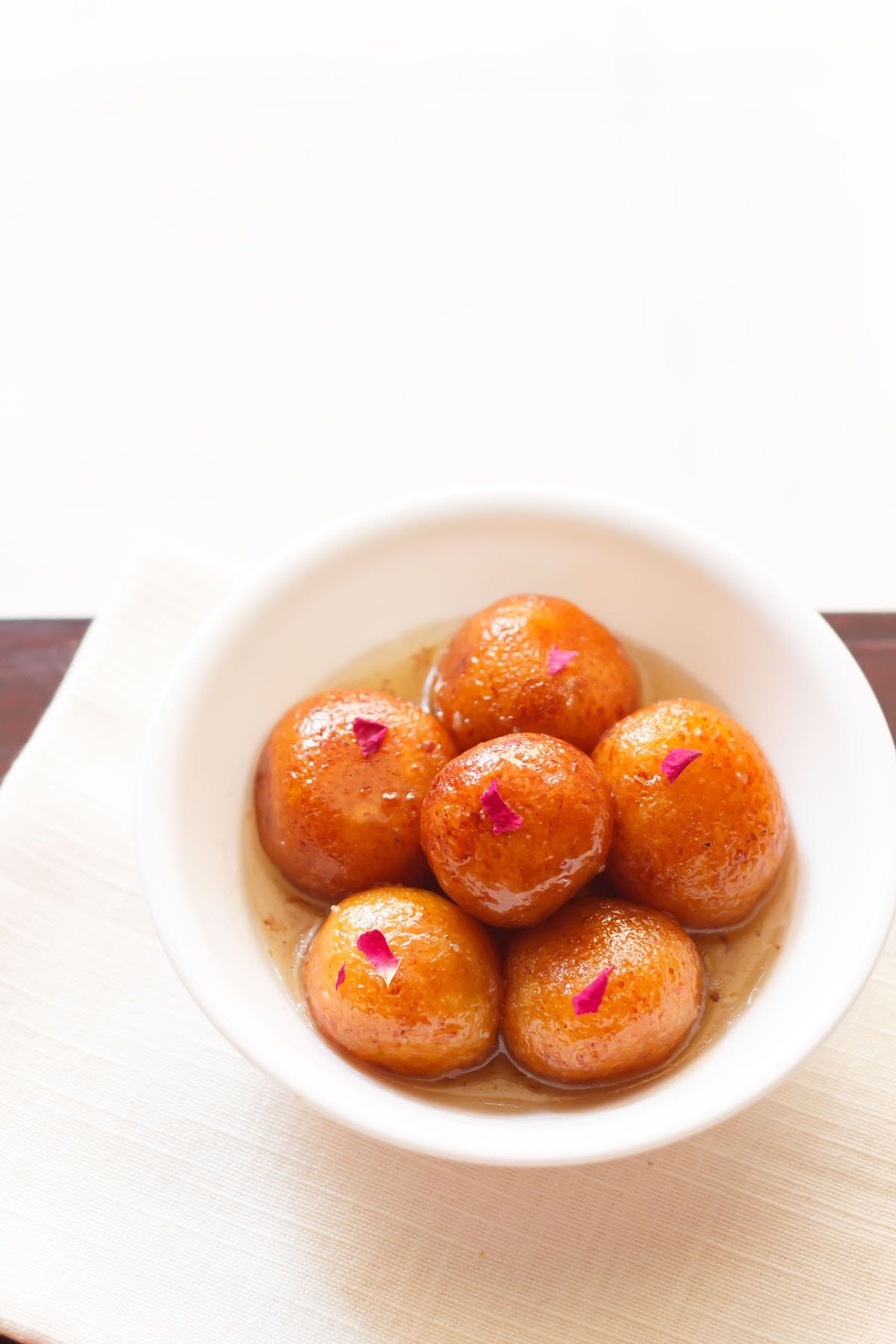
What is Gulab Jamun
Gulab Jamun is a very popular Indian sweet made from deep fried balls of milk based dough that are soaked in sugary syrup. It is a favorite dessert of ours, and we often serve it for weddings, birthdays, festivals, parties or even as a post-prandial treat.
Gulab jamun can literally be translated to “rose berries,” and are so named because the sugar syrup is scented with rose water and the fried dough balls are a similar size to a dark purple berry known as black plum or java plum.
Traditionally, gulab jamun is made with dried milk solids, also known as khoya or mawa in Hindi. This method yields the best tasting and most melt-in-your-mouth texture.
An easy version is also made with milk powder, in case you don’t have access to khoya. In this post I am sharing both versions, so choose your own adventure!
About This Recipe
Authentic Gulab Jamun is always made with khoya or mawa (evaporated milk solids). Khoya is made by continuously simmering the milk on a low heat until most of the moisture evaporates.
There are 3 different types of khoya that you get in an Indian market. To make this gulab jamun recipe, you need to use either “chikna khoya” or “dhaap khoya”. This variety has more moisture than the other two types of khoya, ‘danedar khoya’ and ‘batti khoya’.
Besides khoya, you will also need paneer to make the jamun. The addition of these two ingredients gives the balls a soft, tender texture that is very addictive.
My gulab jamun recipe is an easy one that yields delicious, soft and tasty sweet. It is adapted from the recipe we learned at cooking school, and I have been making it for decades. It has never once failed!
How to Make Gulab Jamun
Follow along with my easy pictorial guide below to make the best gulab jamun you’ve ever eaten!
Make Jamun Dough
1. Take 1 cup khoya or mawa (200 grams) in a bowl. Soft khoya also known as ‘daap ka khoya’ or ‘chikna khoya’ is used. This is a soft khoya, so it mashes and kneads very well.
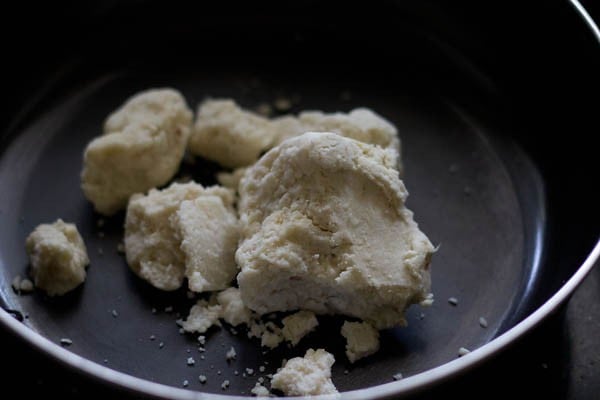
2. Mash khoya very well, ensuring there are no lumps or small bits lurking.
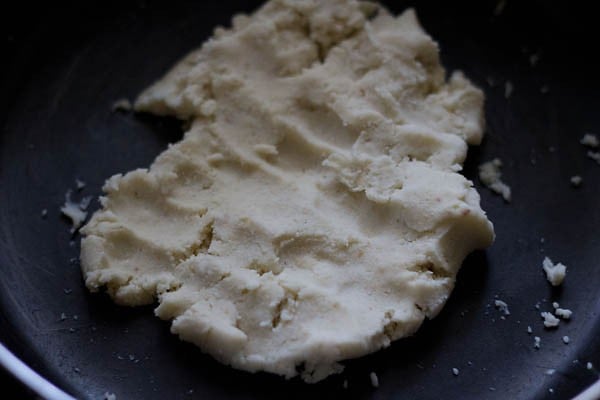
3. Then add ¾ cup (100 grams) grated paneer, 2 tablespoons fine rava (semolina), 2 tablespoons all-purpose flour, ¼ teaspoon baking powder and ½ teaspoon cardamom powder to the mashed khoya.
There should be no lumps in either the mawa or paneer. If there are lumps, then the texture is not even and smooth. The bits and pieces of mawa or paneer give a bite while eating.
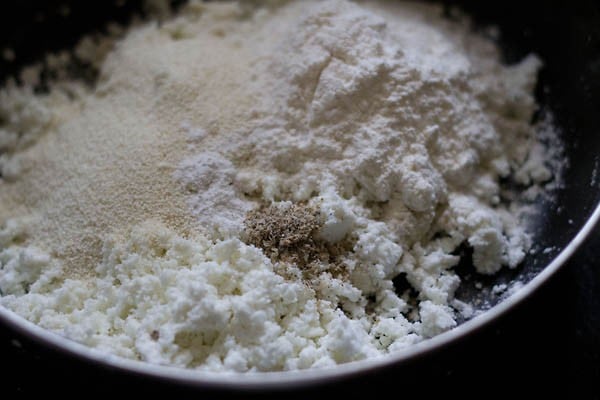
4. Mix well.
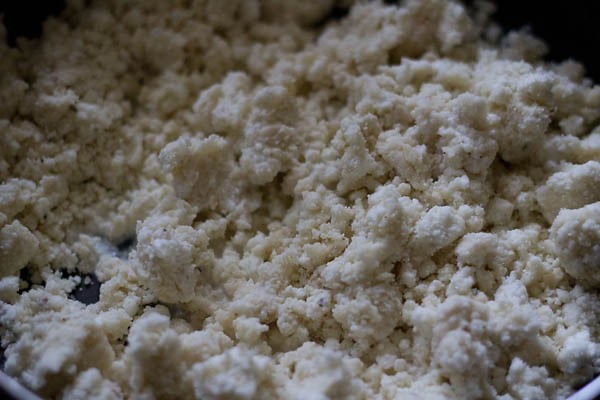
5. Add 1 tablespoon milk and gather together to form a dough with milk. Don’t knead, just gently mix.
If you are unable to form balls or if the mixture appears dry, then add a few teaspoons of milk and mix again. Cover the dough and set aside for 30 minutes.
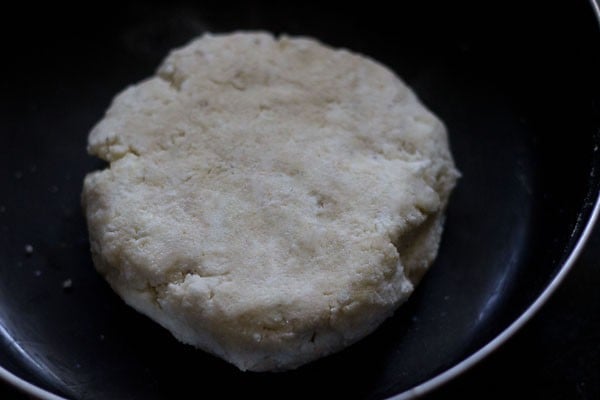
Make Sugar Syrup
6. Mix 1.75 cups (250 grams) sugar in 1 cup water.
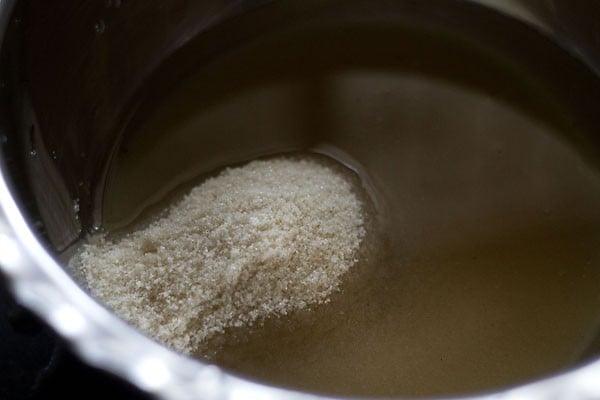
7. On a medium-low flame, heat the sugar solution till it becomes thick and sticky. Just be sure to switch off the heat before the syrup reaches a one thread consistency.
I used raw sugar here, which contributes to the dark color of the syrup.
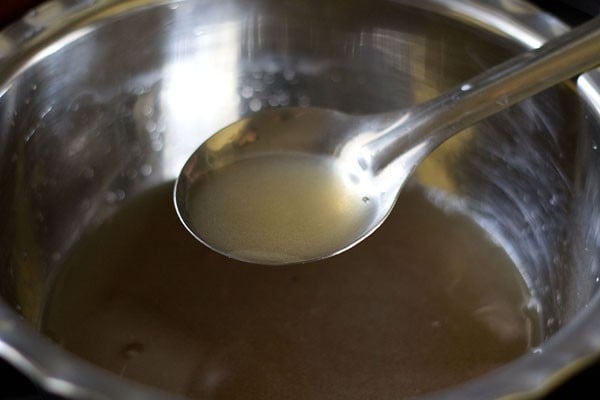
8. Add rose water and stir. Set the sugar solution aside.
If the sugar syrup crystallizes while cooling, then just add 2 to 3 tablespoons water and warm the syrup again. Stir while warming the syrup. The sugar crystals will disappear.
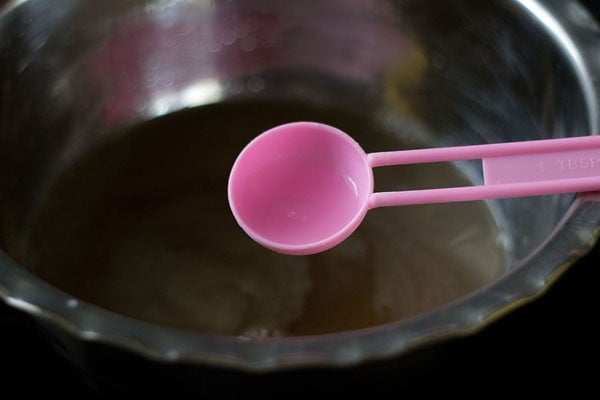
Shape and Fry
9. After 30 minutes, make small balls from the dough without cracks. Cover the dough balls and set aside.
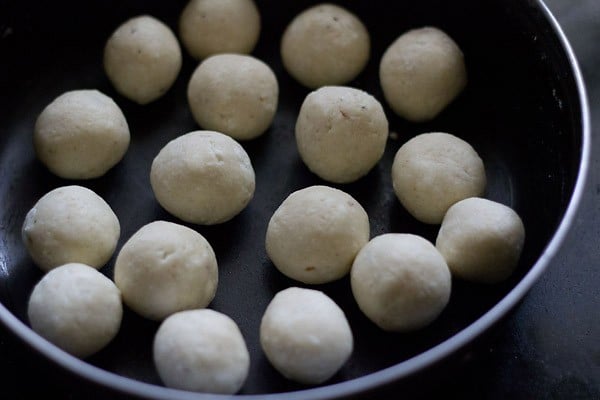
10. Heat oil until it is medium-hot. Lower the heat to a medium-low or low and wait for a minute. Then gently place a single dough ball in the oil.
If the dough ball breaks when frying, then add some more maida (about 1-2 tablespoons) to the dough. Mix gently again. Set aside for fifteen minutes, then shape and fry.
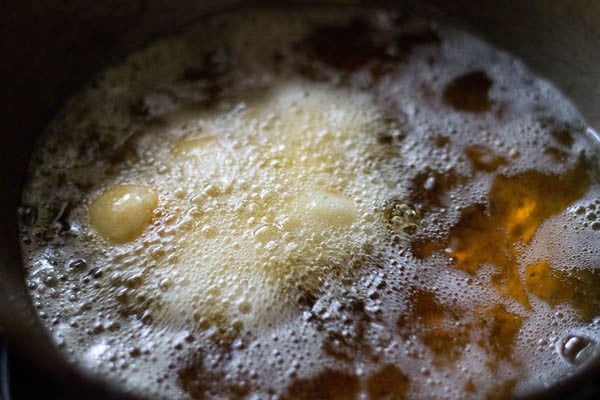
11. Once the jamun start to have tiny golden spots, keep on rotating them in the oil so that the balls are evenly browned. Since I was taking the photos, I browned a few of them more.
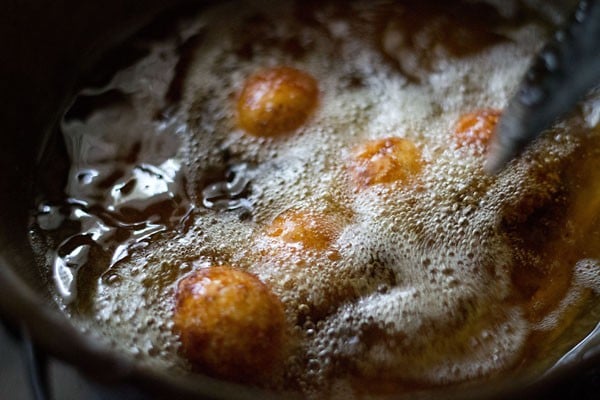
12. Remove the fried dough balls and then place them on paper towels to remove extra oil.
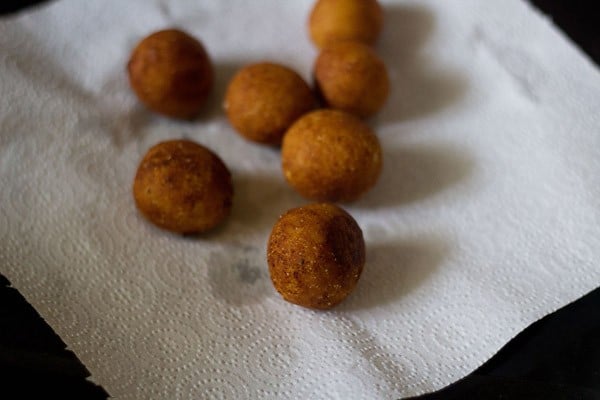
Soak Jamun in Sugar Syrup
13: Place the hot fried dough balls in the sugar syrup. Continue to fry the rest of the dough balls in batches, giving them a quick drain on paper towels before adding them to the sugar syrup while they are still hot.
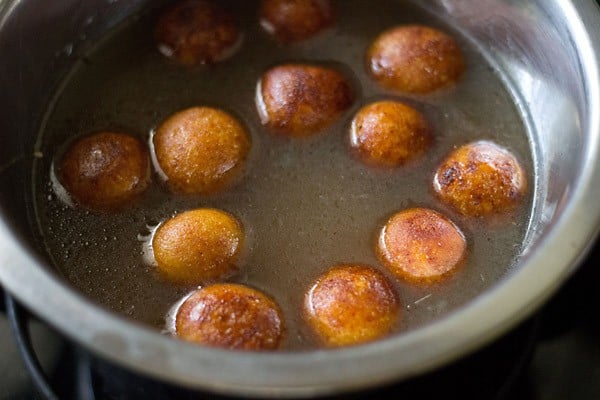
14. When all the gulab jamun are placed in the sugar syrup, then keep the whole pan on a low flame for 1 to 2 minutes. Heating helps the jamun to absorb the syrup and become soft.
The gulab jamun will increase a bit in size during this soaking process. Don’t overcook them, as then they can break.
Use a large enough pan so that the fried jamun balls are not overcrowded and you can easily stir them gently while they are simmering.
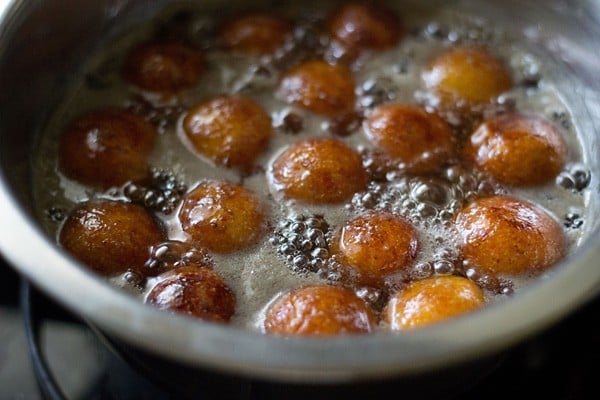
15. Serve gulab jamun warm or at room temperature. You can also chill them and serve them cold. Garnish them with rose petals or almond slivers. Enjoy!
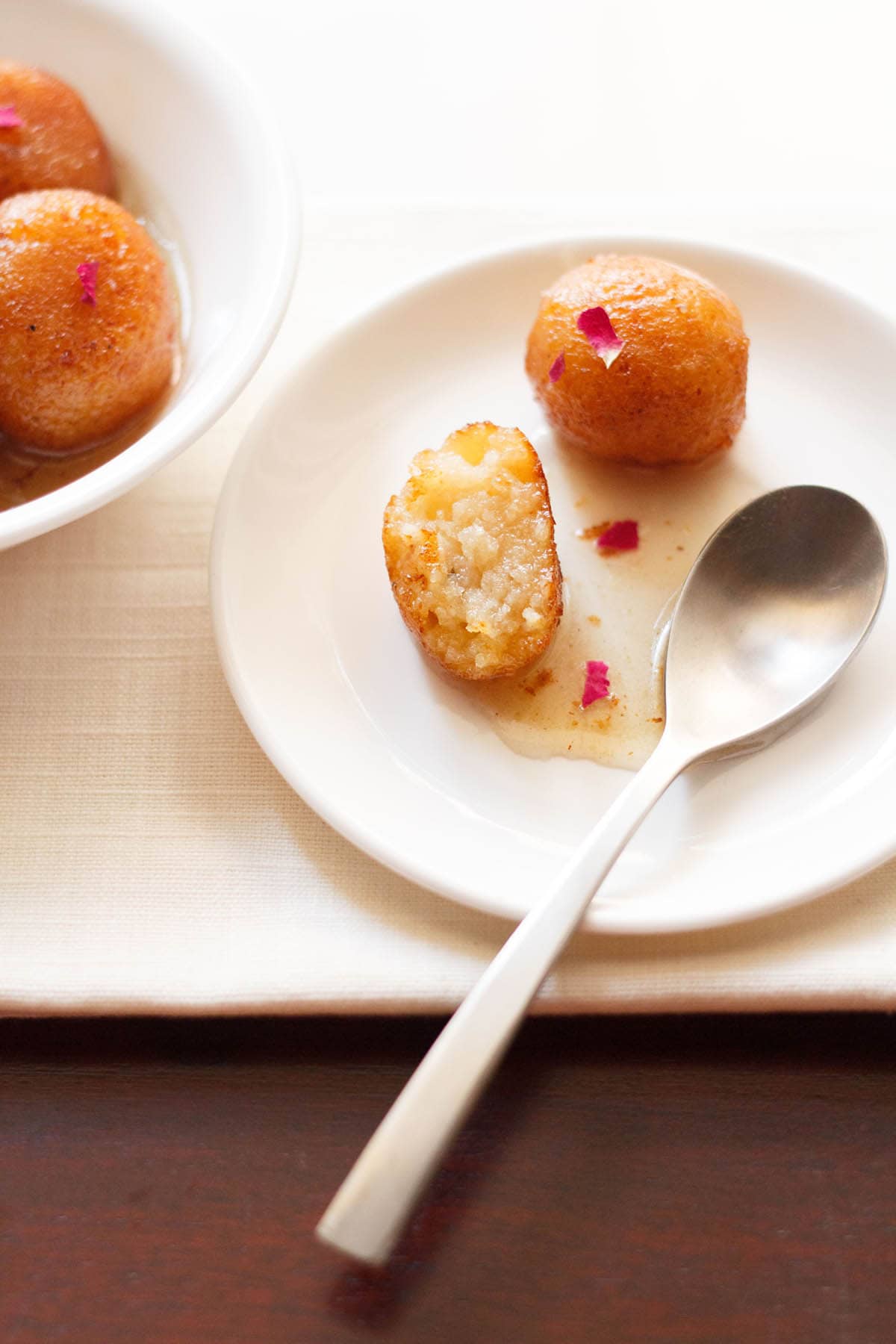
Expert Tips + FAQs
I have compiled below tips and frequently asked questions based upon the queries received from the readers in the comments section.
How to perfectly fry?
Making gulab jamun isn’t difficult, but there are some things you should know about deep frying.
- First, the oil has to be heated till it is medium hot. Then reduce flame to a medium-low or low and wait for a minute. Start by testing just a single gulab jamun to make sure that the oil is hot enough to bubble, but not so hot that the outsides get cooked before the insides get a chance.
- If the oil is on the cooler side, then the jamun will become soggy with oil.
- If the oil is very hot, then the balls get browned quickly with the inside portion being under cooked.
- Once the jamun dough balls start to have tiny light golden spots on them, then keep on rotating them with a slotted spoon in the oil often. This way the jamun will have an even golden color.
- Traditionally gulab jamun are fried in ghee. You can go the traditional way if you want, or just fry them in a neutral oil as I have done.
Why does my gulab jamun break on frying?
There are several possibilities:
- If there is too much moisture in the dough, the jamun will break in the oil.
- Too much baking powder can also result in the jamun breaking and disintegrating in oil.
- When frying the temperature should not be too high or too low.
- If you don’t add enough of the binding ingredients like all-purpose flour or rava (sooji), then this can cause the jamun to break.
- As soon as you add the jamun dough balls in the oil, then let them become slightly crisp and only then turn them.
- When making jamun dough ball, there should be no cracks on it. If you see cracks then add some more milk in the dough mixture. Mix, rest and then form the jamun again.
Why has gulab jamun become hard?
First, check your ingredient proportions. If there is less moisture in the jamun, it may become hard.
The jamun dough has to be mixed and not kneaded. If the dough is kneaded then the gulab jamun will become hard.
When you knead the dough, gluten strands will form which will make the jamun dense and heavy, and prevent them from soaking up the syrup.
Even if they are slightly dense they won’t absorb the syrup and thus remain hard. In fact when frying gulab jamun, it should feel like very light spongy balls. You will feel the lightness in them.
Why is my gulab jamun too soft?
The sugar syrup should have a sticky consistency, not watery. If the sugar syrup is watery, then the jamun absorbs too much sugar syrup, which often results in them breaking in the syrup.
Variations
There are many variations of gulab jamun. The variations vary with the ingredients used or the cooking technique applied. Some of the variations that I have already shared are:
More Awesome Indian Sweets!
Sweets Recipes
Sweets Recipes
Sweets Recipes
Sweets Recipes
Please be sure to rate the recipe in the recipe card or leave a comment below if you have made it. For more vegetarian inspirations, Sign Up for my emails or follow me on Instagram, Youtube, Facebook, Pinterest or Twitter.
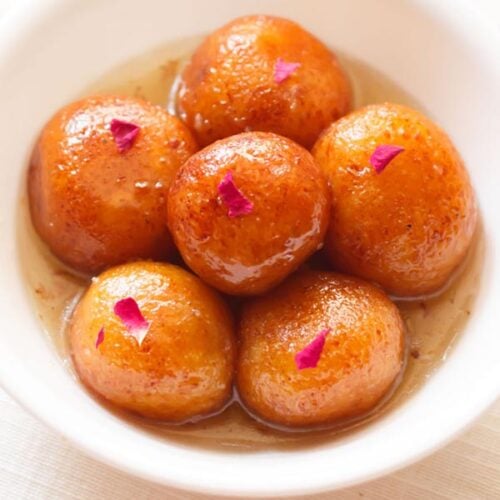
Gulab Jamun Recipe
Ingredients
For the jamun dough
- 1 cup (200 grams) Khoya (mawa)
- ¾ cup (100 grams) grated paneer (Indian cottage cheese)
- 3 tablespoons all-purpose flour
- 2 tablespoons sooji (rava or semolina), finer variety
- 4 green cardamoms – powdered in a mortar-pestle or ½ teaspoon cardamom powder
- 1 tablespoon milk or add as required
- ¼ teaspoon baking powder
- oil for deep frying – as required
For sugar syrup
- 1.75 cups (250 grams) sugar
- 1 cup water
- 1 tablespoon rose water
- 1 tablespoon milk (optional) – *read notes
Instructions
Making dough
- Take khoya (mawa or evaporated milk) in a bowl. Mash it very well. There should be no lumps. You can also grate and then mash the khoya.
- Then add grated paneer, rava (sooji), all purpose flour (maida), baking powder and cardamom powder to the mashed khoya.
- There should be no lumps in both the mawa and paneer. As if they are there, then you will find the texture of the gulab jamun not so good. The bits and pieces of mava or paneer will give a bite in the mouth, when you have the gulab jamun. They won't be smooth.
- Mix well. Add milk and gather together to form a dough with milk. Don’t knead.
- Just gently mix. If you are unable to form balls or if the mixture appears dry, then add a few teaspoons of milk. Cover the dough and keep aside for 30 mins.
- Make small balls from the dough. Cover the balls and keep aside.
Making sugar syrup
- Dissolve sugar in water. Heat the sugar solution till it become sticky. You just need to switch off the fire before the syrup reaches a one thread consistency.
- Add rose water and stir. Keep the sugar solution aside. On cooling if the sugar syrup crystallizes, then just add 2 to 3 tbsp water and warm the syrup again. It will again return to a liquid state.
Frying
- Meanwhile, while the sugar syrup is cooking, heat oil till its medium hot. Lower the flame and wait for a minute. Then gently place the dough balls in the oil.
- Once they start to have tiny golden spots, keep on rotating them in the oil, so that the jamun are evenly browned.
- Remove the fried jamun and then drain them on kitchen paper towels to remove excess oil.
Making gulab jamun
- Then place the hot fried dough balls in the sugar syrup. Continue frying the rest of the dough balls in batches.
- When all the jamuns are placed in the sugar syrup, then keep the whole pan with the sugar syrup and the gulab jamun, on a low heat for 1 to 2 minutes till the jamun become soft.
- Heating helps the gulab jamun to absorb the syrup and become soft. The jamun increase a bit in size. Don’t overcook as then the jamun can break.
- Use a large pan, so that the jamuns are not overcrowded and you can easily stir them gently while they are simmering.
- Serve gulab jamun warm or at room temperature. You can also chill them and serve them cold. Garnish with rose petals or almond slivers.
Notes
Recipe Notes
1. Gulab jamun falls apart while frying: The jamuns will fall apart of break in oil, If there is too much moisture in the dough. More baking powder in the dough can also result in the same. Frying at a very high heat or a low heat will result in the jamuns cracking or falling apart. If the dough has less binding ingredients like all purpose flour or rava (sooji), this would break them in the oil. While frying as soon as you add the jamun dough balls in the oil, then let them become slightly crisp, firm up and then only turn them. 2. Dense gulab jamuns: Less moisture in the jamun dough will make them hard and dense. The jamun dough has to be mixed and not kneaded. If the dough is kneaded then the gulab jamun will become chewy. When you knead the dough, gluten strands will form which will make the jamun dense and heavy. 3. Very soft gulab jamuns: The sugar syrup should have a sticky consistency. They should not have a watery consistency. If the sugar syrup is watery, then the jamun absorbs more sugar syrup resulting in it being super soft and can even break in the sugar syrup. 4. Tip to remove sugar impurities: If the sugar syrup has impurities, then add milk and simmer. A layer of scum will be formed. Remove this layer with a spoon.Frying Notes
- First, the oil has to be heated till it is medium hot. Then reduce flame to a medium-low or low and wait for a minute. Then gently place the jamun dough balls in the oil.
- Once the jamun dough balls start to have tiny light golden spots on them, then keep on rotating them with a slotted spoon in the oil often. This way the jamun will have an even golden color.
- Also do note that if the oil is on the cooler side, then the jamun will absorb more oil and can crack or break too.
- If the oil is very hot, then the balls get browned quickly with the inside portion being under cooked.
- Traditionally gulab jamun are fried in ghee. You can go the traditional way if you want or just fry them in oil as I have done.
Nutrition Info (Approximate Values)
This Gulab Jamun recipe from the archives was first published on August 2014. It has been updated on November 2024.
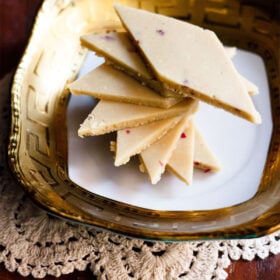
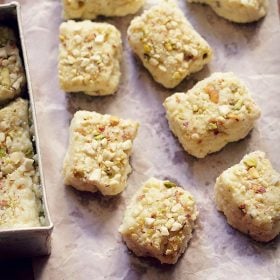
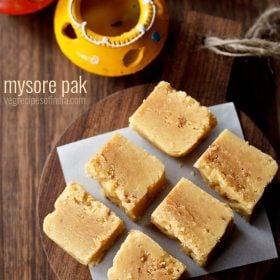
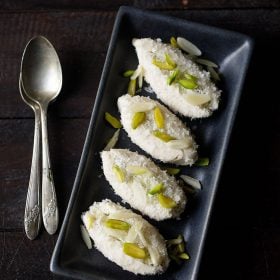
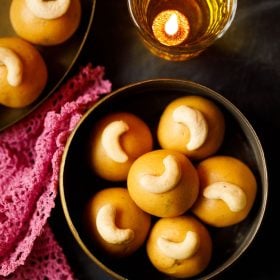
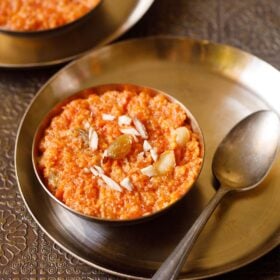
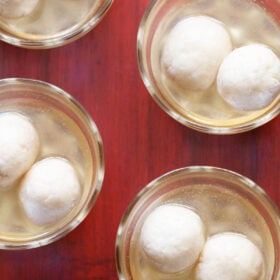








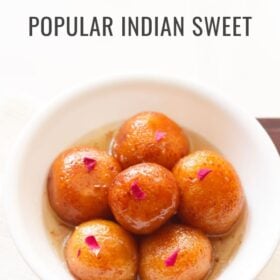
Dassana mam milk powder gulaab jaamun balls ko fry karne ke pehle cover karne ke liye koi bhi towel chalegaa aur balls kitni der tak cover karke rakhnaa hai??
Any cotton napkin or cotton kitchen towel will do. You can cover until you are ready to fry them. It can be around 5 to 10 minutes and not more.
Dassana mam agar kitchen towel nahin ho toh koi bhi towel chalegaa?
Any kind of towel will not do. You can use any clean cotton handkerchief or a clean cotton napkin.
Hello Dassana Mam. It is important to cover milk powder gulab jamuns with kitchen towel?
The fried gulab jamuns are placed on a kitchen paper towel so that any excess oil is absorbed by the paper towel. That is the only reason, but you could use clean paper tissues also.
If you do not have any of these kitchen paper tissues, then simply skip this step. Just fry them well enough so that the jamuns do not absorb a lot of oil.
Dassana mam, milk powder gulaab jaamun mein humko balls banaane ke baad aur fry karne ke pehle hamein jamuns ko kitchen towel se cover karnaa hai?
Yes, the jamuns need to be covered with a clean cotton napkin, so that they do not dry out.
have made this sweet dish before and have to say although it takes a bit of patience it is totally worth it…
and i recommend really sticking to the instructions and you will get a far better result than you would have expect it !!
also next day the gulab is far more rich as it had time to soak in all the goodness of the flavours that the syrup has to offer !! Bon appetit 😉
“ohh boooy” adventuring myself to try and cook these for the first time tomorrow. have eaten plenty of times in restaurants before and it’s been one of my favorite indian desserts for a long time.
this is going to be one of my desserts of the last night of the year, so will try my best to get best consistency dough balls to handle the heat of the oil ! i have guests so they must look and taste good !
seems a precision recipe due to oil temperature, sugar thickness, balls consistency, but hey, this is going to be a great success just like any other that i’ve tried from your website before – thanks to you dedicated focus in detail description dassana !!
thank you once again !
Thanks for the detailed comment and most welcome. I hope you had success making this recipe.
Maida is allergic. Can we add sooji only to 200 gm of mava Please tell me how much of sooji be added
You will need some binding ingredient instead of maida (all-purpose flour). Try using any flour or ingredient which you are not allergic to. A few examples are almond flour, rice flour, besan (gram flour) or chickpea flour, arrowroot flour, breadcrumbs, or any cereal or millet flour.
But keep in mind that the gulab jamun will get the flavor of the flour if it does not have a neutral taste or flavor. Adding more of sooji can result in a hard or denser texture.
Hi,
Can I replace the sooji with maida?
yes you can skip sooji and add 1 to 2 tablespoons more of maida.
Hi Dassana
I wanted to inquire about doubling the recipe. How would I go about with the amount of flour and Sooji. I did 6 Tablespoons of Maida and 4 Tablespoons of Sooji and ended up with polka dot Gulab Jamuns that resembled strawberries ???? So I guess 3 Tablespoons of Sooji would be sufficient?
radha, whenever sooji is used, one has to be careful. firstly too much of sooji can make the dish hard or dense. and when sooji is added it absorbs moe moisture or water content from the mixture or batter. so here in this case, some more liquid ingredients like milk or water can be added, so that the sooji softens and does not remain crisp – nor you can see the fine dots of sooji in the dish. in this recipe, 4 tablespoons sooji will be more. so just 2.5 to 3 tablespoons. your guess is right ????
Hi Dassana, Your recipes are wonderful and so spot on. I have been meaning to say this on so many posts of yours that I try- but today I am posting this as I have run into an issue and I am hoping you might be able to tell me why.
The first time I made your Gulab jamun they were just fabulous. Then the second time ( I bought a different Khoya- this was softer) and made it and all the dumplings when I put them in the sugar syrup went in , in the middle. I had half that Khoya still- saved it up and made it again today and this happened with some and not all.
What am I doing wrong- did I put in the dumplings too hot into the sugar syrup?
Your recipes are so very good.. thank you for sharing them.
thanks meena. i have also used softer khoya in the recipe. gulab jamuns have to be hot when adding sugar syrup. could be that the sugar syrup was either not a perfect one string consistency or the khoya must be more on softer side. what you can do is do not heat up the sugar syrup once you add them in it. just let them soak in the syrup. hope this helps.
Hi Ms. Dassana,
I have tried several recipes from your website and others but the measurements that you give are absolutely perfect. Gulab jamuns i used to make had some or the other problem but with your recipe turned great.
Thank you for your marvellous recipes.
Welcome Amera. Glad to know this. Thanks for your positive review on gulab jamun recipe.
Ms Dasana, Hi!
I do make gulab jamuns at home and they usually come out well. Your recipe with measurement along with people’s encouraging comments seems too helpful as my method is how I had seen my mom prepare when i was a child.
Here i would like to clear a doubt. You said in one of the replies above that Baking soda can be replaced with Baking powder. But is it true? They have a different composition, aren’t they?
thanks sona. glad to know. in this recipe both baking soda or baking powder can be used. does not make much of a difference as small amount is used. they do have different compositions but for recipes like gulab jamuns, pakoras, koftas etc, they can be substituted with each other.
Hi dasana ,I tried gulab jamun recipe.and it was nice.i would love to try other recipe of your .
Thanks Ankita. Nice to know this.
Can you give a gluten free version please.
Sirisha, i have never tried gluten free version.
Hii, i was just having one qwery… Can baking powder be replaced with baking soda?? If not then what else can be used… I m huge fans of yours and ur dishes..
jyoti, in this recipe you can use baking powder instead of baking soda. and thanks a lot.
I don’t know if this has been answered before.. but, what exactly is the purpose for the paneer? I have seen some other recipes with khoya which don’t add paneer.
I made your recipe yesterday and it was amazing! I guess my Gulab Jamuns were too soft because after soaking in the syrup. They started breaking whenever I touched them with a spoon. I’ll just have to try again next month.
radha, paneer gives a softer texture. the sugar syrup has to be sticky and about 1/2 string consistency. if the sugar syrup is watery, then the jamuns will break. hope this helps.
Thank you so much. I made another batch and it was successful! Amazingly soft and melt in your mouth. The best recipe I have tried to date. Just fantastic. Thank you so much!
Welcome Radha. Glad to know this. Happy cooking.
Its a perfect recipe, never goes wrong, so many times i have made it, but forgot to thank you, so thanks a lot for such a sure shot recipe, i wish i could share pics of my beautiful gulab jamuns
Welcome Pooja. Thanks for sharing this awesome feedback on gulab jamuns.
Hi Dassana, I want to try this recipe but have a quick question….Can i use frozen khoya? We only get frozen khoya here in NZ. I will thaw it and bring it to room temperature before using. This will be the first time i’m making gulab jamuns from scratch..i’ve always bought the ready mix..so just wanted to make sure i get it right. Thank you!
Welcome Yogita. You can use frozen khoya but bring it to room temperature before you use it.
Hi mam..h r u? U r really great and tried ur most of ur recipes everything turned out excellent.. Tried this way of making jamuns three to four times..it turned out well..but last tym my jamuns outer layer was crispy but didn’t break anywhere.. Soaked in syrup..but I didn’t get round shapes for some of the jamuns..but while trying previous tym and all it turned very perfect..this tym ly the shape made me disappointed.. But melted in mouth..don’t know where I went wrong? It puffed up while frying with round shape and while taking from the oil the shape got changed..otherwise everything was OK and too good..thank you..
thanks radhi. firstly the jamuns need to be fried in small batches. this depends on the size of the kadai. if they are fried in large numbers, the shape changes. also when soaking, there should be enough room for expansion. if the bowl size is small, the jamuns will not have a round shape. other than these, i don’t see any reason for the shape getting changed as you have mentioned that the taste and texture was good.
Thank you for the awesome recipe. I followed your directions, doubled the recipe and added another tablespoon of milk. It was fantastic. I used the rosewater and it really made a huge difference.
To anyone trying this recipe, please follow the directions. Especially on the part where you do not knead the dough. Only mix it and when forming the balls pack it in carefully.
thank you anshu for this lovely feedback. rose water does make a big difference. also the recipe can be doubled easily. wish you a happy diwali.
Such a perfect recipe it is..‼ …yummm gulab jamuns dat got over in no time…also noone could make out dat they r home made….can’t thank u enough mam…☺
thanks divya for the positive review. good to know that that gulab jamuns got over quickly.
i tried ur recipe and it turned out fantastic…
i never had such soft and melt in mouth gulab jamuns…
bt i want to make them a bit tight… as they are served in shops… mine were very soft… taste was awesome bt plzz suggest if there is a way to make them a bit tight so that they will retain their round circular shape…
thanks fr posting and sharing..
i hv also made paneer and khoya at home… and the paneer was soooooo delicious…
thats great kavita and thanks for this feedback. for a firm gulab jamuns, fry them a little more and also do not heat the syrup after you keep them in it.
Hi Dassana,
I would like to let u know that I am an absolute fan of your blog .Whenever i decide to try some things new I always stick to your directions and the result is amazing as always .So thankyou so much and keep up the good work.I had made Gulab Jamuns with khoya and paneer on this Karvachauth for thr first time and they came out perfect.Even got compliments from hubby ?
Thanks so much ?
thank you priya. also thanks for sharing your feedback on the gulab jamun recipe. most welcome.
Thanks for this recipe.
Tried it came out very well.
welcome ipsita and thanks for positive views 🙂
NICE
thanks miku for your feedback.
Tried this recipe and it turned out to be perfect!!
thanks loveena for sharing positive feedback on gulab jamun recipe.
awesome recipe.. have u posted the recipe of paasta if yes than plz share and if not than plzz update..
anita veg pasta recipe is there on the blog here is the link to veg pasta recipe. hope this help’s thankyou.
I really liked this site showing very easy nd clear methods to make receipes
thankyou so much milky 🙂
I love gulabjamuns n sure with d help of ur recipe I will make it soon
sure sangita let us know how they turned out and thankyou 🙂
Very easy to follow. Delicious food. Thanks!
thankyou theresa 🙂
I like and i am so much fond of making every recipie.
thankyou hanief 🙂
Hi..i have bought lasa khoya(which is specially used to make gulab jaman) so can i make gulab jaman using that lasa khoya and remainig ingrediants according to ur recipie?
yes you can use this khoya with this recipe of gulab jamun. you can also have a look at this recipe of kala jamun – https://www.vegrecipesofindia.com/kala-jamun-recipe/
Thanks for the recipe. But I have a problem. My gulab jamun were soft n good to taste but were not spongy…… The syrup didn’t enter the balls well. I took 1 cup each of mashed mava and grated paneer. 1/2 cup maida and 1/4 cup sooji n added baking powder. I don’t understand what went wrong? I think I added less sooji. Why is the sooji added anyways. Help me out. I want to make it for diwali.
you have a taken more of the maida and sooji. the maida is used for binding and half a cup is too much. sooji is also used for binding but also as it makes the jamuns soft. thus the jamun balls have become hard. just follow the recipe. in this recipe, you can even skip the sooji.
Can u please suggest
in one kg khoya how much suji is required…
Thanks
komal
i am not sure how much as i have not measured the suji in grams. so for the recipe, you will have to increase everything proportionately.
Hi Amit,
I tried this Gulab jamun recipe… And it was yummy… I had also tried gravy manchurian that was amazing too… Thanks for the detailed explanation about cooking with important notes…
Well i read in comments that some people are getting problem when balls are spreading while it was deep fried… Same thing happened with me too… And to make the dough fine again i mixed some more maida(2tbsp) in it and kept it aside for fifteen minutes and then the balls got fried perfectly without spreading at all in the pan…
Thanks again keep cooking and sharing the delicious…
thanks madhuri for the positive feedback and also for the tip you have mentioned. will help the readers. i will also mention this in the post 🙂
Sarwat AAP KI RECIPES TARI KI POORI OUR PARFCT TTHI TANKS.
welcome sarwatperween
All the recipe are very tasty.i’ll make lots of paneer recipe.thanks
welcome aditi
I tried this today. But it was very soft. Can I use extra soji and maida next time.
yes you can.
Hi,
I am planning to make gulabjamuns tomorrow using your recipe. I have bread flour at home. Can I use bread flour instead of all purpose flour ?
Thanks in advance. 🙂
welcome kanan. i am not sure, you will have to give it a try. i have never worked with bread flour. so can’t say.
I did exactly as said in the recipe starting from the homemade khoya and paneer. I had let the dough for one hour though. Just that was different from your recipe. Balls were made fried on low flame, kept on paper towel,made the syrup and put the balls in straight away and kept on low flame for a while and when we were going to serve it,it became totally crystalized. So we added water and warmed it up and served it and it still crystallized. Very disappointed! Why could this have happened?
the sugar has crystallized. try adding some lemon juice in the syrup and you wont’t get crystals. also i think you cooked it again too much thats why the crystals were formed. i would also suggest not to allow the dough to sit or rest at room temperature.
All who tasted the gulab jamun were pleasantly surprised and did not believe the recipe till I opened your blog and showed them. Came out really well and was worth the hard work of mashing the khoya and paneer :). Rose water added beautiful aroma and the whole package was a delight to all who tasted it. Your recipes earned some more followers and admirers. Your recipes bring out a lot of confidence in people who have thought for years that cooking is not their cup of tea. Thank you once again for your contributions in such an important part of our daily lives
welcome hemanth. thanks for sharing your positive feedback. you are actually very good in cooking. because i have got some comments where few readers have not got the gulab jamun right. we feel its little tricky to make gulab jamun at home but its not. thanks for sharing the blog with your friends.
Please indicate the exact temperature of the oil?
nitay, i didn’t measure it while making.
In this recipe, khoya 100 grams and 100 grams paneer ?
200 grams khoya and 100 grams paneer.
But in ur recipe ingredients given above its showing 200gms of khoya and 100 GM’s of Paneer
yes thats right.
Hello
Dasanna did try out the gulab jamum today.
It turned out pretty good. However that some jamums started collapsing inside. Maybe due to the action of baking powder, I did follow your instructions and added 1/4 tsp , still that was the result. Otherwise the taste was excellent. When in your mouth as you bite ,I could feel the paneer taste. Can we avoid paneer.
Thanks for the recipe.
hi raveen, i could not get what you mean by collapsing inside. in this recipe paneer has to be used. if you grate or crumble the paneer very well and mix it evenly then you won’t get the paneer taste. grate paneer with a grater having small gratings.
Hi Dassana tryd gulab jamuns turned out vry nice, thks for the delightful recipe.
welcome mohini
Hi, I am planning to throw a party for my 2 yr son bday. I am from Lucknow UP . I was planning to make choose , palak paneer n kalaugi. Plz can u suggest some better option. I am not sure about d combination. With this I was planning to make poori kauchaudi rice n raita. Plz suggest, it wud b a real help
deepti, i don’t know what is kalaugi. palak paneer will go well with rotis or naan or tandoori roti. you can also try aloo rasedar or mathura ke dubki wale aloo with poori kachori. these aloo recipes are posted in the blog.
Hi Dassana,
I tried this recipe but must have gone wrong as the jamuns were hard. I made a few errors. Added double the amount of paneer, realised it later after mixing. I took care of ensuring a grain free dough, however the jamuns were still ‘daanedar’. Did you use store bought paneer or did you make the paneer yourself? The khoya I had was pasty not crumbly as you have mentioned. Also the chachni was made well but by the time I added the jamuns it had thickened a bit, I felt it was a bit less for the jamuns. Do the jamuns also harden if they are cooked on a slow flame (longer time)?
hi deepti, sorry to hear that. we all mistakes. even i do. proportions are important. the paneer has became too much. i made the paneer at home. khoya has different textures everywhere. what i get outside is a soft textured one. the chachni thickens on cooling and even will get sugar crystals. you can either keep on a hot water bath. meaning keep the chachni pan on a large bowl or handi containing some hot water. or you can add 3 to 4 tbsp of water and warm the syrup again. for a longer time if you cook, the jamuns will get a coating or crust of the sugar syrup which will change to a 2 to 3 thread consistency and make a hard crust around the jamuns. so they will harden from outside. the syrup has to be in the same consistency throughout. some water can be added while cooking the jamuns.
Hi Dassana,
I shall try again. Next time I shall use homemade paneer how do you measure the weight in case of home made paneer? Learnt a few lessons :).
I shall be making rasgullas tomorrow for husbands birthday. Have noted your recipe for the same.
i have a weighing machine at home. so i measure in that. we all learn deepti. even i learn 🙂 have a great day tomorrow.
Thanks! Can you advice if the jamuns are made first and then the syrup, will it make a difference in the texture of the jamuns? Will they harden or not swell if they cool before adding to the syrup?
i make them simultaneously 🙂 first the syrup is made and then the jamuns are added while hot in the syrup. the syrup has to be warm or kept on a hot water bath. what you can do is make the balls and cover them with a moist cloth. then make the syrup. once the syrup is done, heat oil and fry the jamuns. quickly drain them and place them in the syrup.
Baking powder is necessary….can I skip it
And Without baking powder the softness will same
rakhee, baking powder is required. without it the softness will reduce.
Hi Dassana,
From where do you procure the rose water ?
ashwini, i buy from a local super store. there are two types of rose water. one is edible and other is meant for skin and eyes.
I searched for edible rose water in 4-5 stores including Godrej Nature basket with no luck.Can i substitute it with something else or do i skip adding it to the syrup?
ashwini, i also searched for rose water online, some days back. but could not get. let me know where you are based. i can let you know where you will find rose water, if you are based in mumbai or pune. instead of rose water, you can add 1/2 tsp cardamom powder along with a few crushed strands of saffron. saffron is not essential, but for fragrance you can add them. also if you have kewra water, you can add that too.
Hi! Can I skip the milk? And is it necessary to let the dough rest for thirty minutes, can that be skipped as well?
Lastly, what difference would it make if I fried the balls in ghee?
sammy, you can skip the milk. you have to allow the dough to rest. you can fry the balls in ghee. the gulab jamun will have a nice aroma and flavor of ghee.
This is the first time i’ve tried to make those. I used home made khoya (which I followed instructions on on your website on how to make 🙂 ). I didn’t have any paneer so I used yoghurt instead and it turned out to be really tasty. Thank you so much for your lovely recipes.
thanks for the feebdack neelopher.
I tried this recipe. Unfortunately forgot baking soda while mixing. Also had to stepout of the house so the mixed dough stayed for 3 hours in fridge. I used grated khoya and grated paneer along with Maida and Suji. The balls were very hard and did not plump up. There was a bite to them as you could feel the grated paneer. Wondering if should have put grated Khoa and Paneer in a mixie. Normally I use your other recipe with just milk powder and have received excellent comments. This time no one touched them.
okay.. firstly the mixture should not have been refrigerated. did you bring it at room temperature before frying? the paneer gratings have to be fine. the khoya also has to be mashed. if the khoya is not mashed, the balls will become hard. baking soda does help in making the balls soft, but in this recipe, it can be skipped. since the paneer and mashed khoya will make the balls soft. next time you can run both the khoya and paneer in the mixer, but just take care that fat is not released from them. it will spoil the texture.
Hi,
This is the first that i tried..came out super good.The paneer was new twist to it.Many thanks for posting such a wonderful recipe
welcome radha. thanks for sharing positive feedback.
Thks for the wonderful recipe, culd u also post recipe for rasgulla and jalebi please.
welcome Mohini. i have noted down the recipe request and will try to post the recipes in coming months.
Thks for ur prompt reply really appreciate that.
welcome mohini
Assalamoealikum mashallah very nice some new things for me to learn more..um head chef in restaurant…
This is great site
Br
thanks nasir
Can I use Riccota cheese in place of khoya after reducing the water. Also is it ok to use cottage cheese instead of regular paneer. thanks.
it is a very very awesome website…. i really like it very much…… i tried our recipe it was really very nice thanks a lot for putting such nice and easy recipes for people like us…
thanks janani. glad to know this.
Hi,
I tried your recipe today…but they are not that soft as i forgot to put them on flame after placing in sugar syrup.
Is there a way they can become soft now?
Thanks:)
hi isha, warm the sugar syrup and heat lightly. they will become soft.
thanks:)
I tried your recipe…….taste was too gud but the gulab jamun were too soft and some of them broke as we took them out from syrup. What wud b the reason..??
the reason would be they got cooked too much in the last step or the dough was too moist or soft. this could be the reasons that some of them were breaking in the syrup.
Hi,
Is it possible to make these without the flour and sooji? I was looking for a gluten free version
Thanks
flour is added, even though you skip the sooji. it helps in binding. another way i would suggest is to use some other flour instead of all purpose flour or use mashed sweet potatoes. just make the balls, with khoya, mashed sweet potatoes and corn starch. this will be an experimentation and you will have to adjust the proportions accordingly.
Hello Dear,
Thank you for all the wonderful recipes. I was curious about edible rose water. Can you share what brand or how you buy or make rose water? Also, I would like to know which saffron brand you use.
Thanks for helping.
Thanks dear,
Ami
thanks ami. i have a syrian brand (ebla) of rose water, that i use. saffron i use an indian brand (tulip) and a spanish brand (tajmahal).
Hi I live in the British Virgin Islands. I would like to make these. Can you let me know what type of yogurt I can use.
thanks.
dharma, you can use plain unflavored yogurt.
Totally loving your site. This post has reminded me of my childhood when mom would make two huge containers one of gajar halwa andand other of gulabjamuns and Ialways liked gulabjamun. I prefer home made gulabjamun over readymade ones anyday. This recipe is a keeper.
thanks shivani. do try this recipe. its a tried and tested recipe.
Hi samy east or west india is the best as we get khoya here for making yummy gulab jamuns which u dont get in us
Heyy..your all recipes are fabulous..if I don’t wanna add paneer in gulab jamans..will it be ok?
paneer is essential in this recipe. if paneer is replaced, then the whole recipe will change.
Hi Dassana, I live in Spain where to find khoya is impossible. So if you may please guide me with it’s replacement and correct proportion. It would be a great help
dipti, you can use canned evaporated milk.
Hey I made this today….. They turned out fab and recipe is so simple and Delicious…. Thanks Dassana
welcome apeksha
Dear Dassana,
Can i use the evaporated milk that you get at the store instead of Khoya. I live in the US and Khoya is difficult to find.
Love the recipes onthis site
Thank You
you can use it.
I wish I could mail this recipe to my daughter.
Hi Dassana,
I have tried few recipes from the south indian cuisine section by u and they turned out quiet nice.
This gulab jamun recipe u shared is so simple and full of flavors and i’ll for sure try it in this week.
thanks apeksha
Finally made it today and they were fab… My mil used to bring ready to eat packs and make them but today i insisted her to follow your recipe. She was ok and when we made it she was like they r fab and so simple to make….
Thanks Dassana
welcome apeksha. glad to know that you and your mil liked the gulab jamuns. thanks for sharing the positive feedback.
Very interesting..just yesterday my husband was complaining that I never made gulab jamuns and he was requesting for one made of khoya and today you actually post one!!!!..how can you ensure that there are no lumps in the paneer?passing it through a sieve or just running it in a mixie for few seconds?
i always grate the paneer and then add. there will be no lumps then. if one uses a short cut and mashes the paneer without grating, then there will be lumps. no need to run in a mixer as this will release the fat from the paneer and change the texture of the jamuns.
Thank you Dassana.
welcome ashwini
Another doubt…which kind of rava would you use for this recipe..chiroti rava/fine rava or bombay rava/medium coarse rava?
fine rava ashwini.